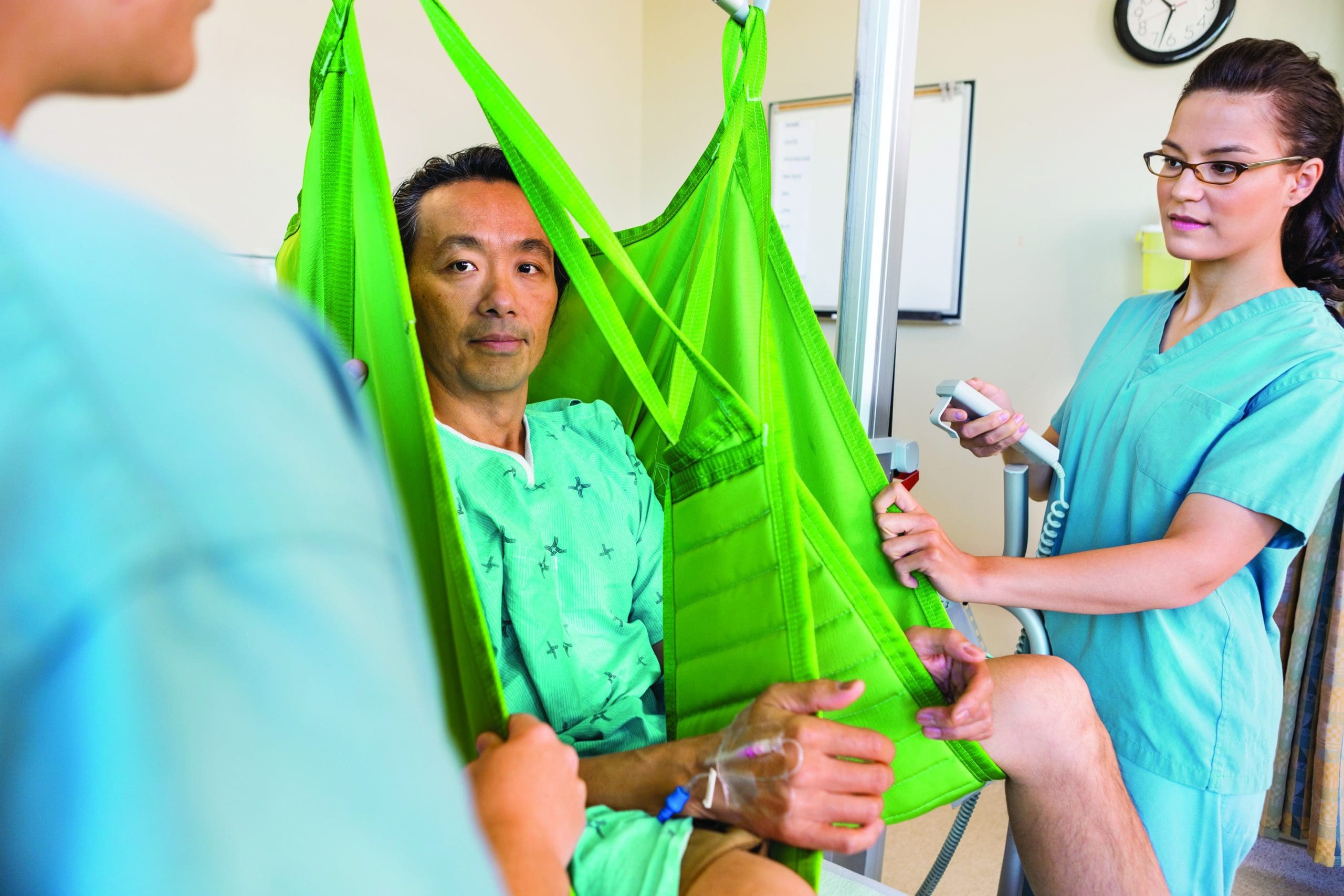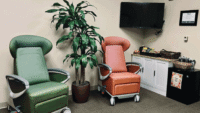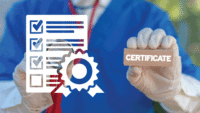Following this advice can help protect you and your patients.
Takeaways:
- “Safe patient handling and mobility” is the catch phrase all nurses need to know, not only to foster health in the lives of their patients, but in their own.
- Recommendations for bedside nurses include using mechanical lifts, knowing the limitations of body mechanics, and advocating for their own safety.
Nursing is a demanding job, but it shouldn’t demand injury to the nurse, especially when injury can be prevented. Far too many nurses suffer musculoskeletal injuries (such as back and shoulder muscle strain or vertebral disc herniation) as a result of routine work duties, despite many strategies available to reduce these injuries. Nurses typically experience injuries caused by overexertion, excessive physical effort, or repetitive motion. According to the U.S. Bureau of Labor Statistics and Samaei and colleagues, as many as three-quarters of nurses have experienced back injury and pain from working with patients, and most of those injuries were recent (occurring in the previous year). This rate of musculoskeletal injury is among the highest of all industries and professions in the United States.
Government and healthcare provider associations are paying increasing attention to nurses’ musculoskeletal injuries related to handling patients (lifting, repositioning, ambulating), but successful policies and procedures require nurse input. The American Nurses Association (ANA) recognizes the value of nurse participation in planning policies and programs, and its Safe Patient Handling and Mobility: Interprofessional National Standards recommends nurse input and feedback. Successful safe patient handling programs use engineering, behavioral, and/or administrative interventions; however, to be effective, all of these programs require nurse involvement not only for adherence but also for self-advocacy.
7 safety tips
As you work within your organization to develop policies and procedures that protect you and your colleagues from injury, keep these seven tips in mind when moving patients.
1 In this age of do-it-yourself, don’t
Sharing the load—with lift teams or a mechanical assist device—decreases the compression strain on your spine. A quick-but-imperfect way to estimate if you need help with patient handling is to assess the patient’s ability to assist with moving, and then consider the weight you’ll have to support. If you’re shifting more than 35 pounds of a patient’s weight (the weight of a cinder block or a midsize microwave), call for reinforcements. Remember that you can’t safely lift a patient alone because you can’t keep the weight close to your center of gravity. Make mechanical lift devices part of the “reinforcement” team.
In addition to helping with the actual task of moving a patient, coworkers can help ensure adherence to organization policies. Nurses are more likely to use safe patient handling techniques if they have coworkers’ and management’s support. Peer pressure, management guidelines (such as a “no-lift” policy), and the risk of back pain can all influence nurses’ motivation to use mechanical lift devices. And a supportive environment aligns with the first of the interprofessional national standards the ANA has recommended for safe patient handling: Establish a culture of safety.
- Don’t lift patients by yourself.
- Keep in mind that repetitive strain can seriously injure your back.
- Remember that body mechanics can’t protect your back during lifts.
- Your safety and well-being are in the best interests of your patients and employer.
- Using mechanical lifts requires sufficient time and adequate space.
- Know where lifts are and how to use them.
- Report an injury as soon as possible.
2 Know that injury isn’t always from a single event
Yes, you can throw out your back with overexertion from a grand heave or lift, but repetitive lifting of lighter loads can have a cumulative damaging effect on your spine. Frequent biomechanical stressors can outpace your body’s ability to repair itself (similar to the mechanism of a stress fracture). The concept of cumulative damage is probably one of the least familiar principles of safe patient handling, making it the most likely to incapacitate healthcare workers.
3 Remember that body mechanics aren’t enough
Although practicing proper body mechanics in general (such as raising the bed to at least knuckle height to assess patients) is important, it doesn’t provide protection from injury when lifting is required. The significant amount of weight involved and the often-awkward positions patient handling requires make manual lifting techniques inadequate at reducing injury risks. Again, the hard-and-fast rule is that manually lifting a patient by yourself isn’t safe, and it can be dangerous even with coworkers’ help.
4 Don’t accept injuries as “part of the job”
Occupational injuries are never “just part of the job.” You have the right to protect your body, and your employer has an obligation to ensure your safety. The nursing culture tends to prioritize patients’ needs above those of nurses, but when you protect yourself from harm you can be a better caregiver. Think of it this way: You can be a more effective nurse in the short-term and the long-term if you maintain your musculoskeletal integrity. Your employer benefits as well: Investing in nurses’ long-term health (by providing safe patient handling training and mechanical assist devices) costs less than paying for shortsighted decisions in workers’ compensation claims, lost workdays, modified duty days, and high nurse turnover from fatigue and injury.
5 Take the time and space to do it right
Nurses frequently work under tremendous time pressure, but patient lifting isn’t an area where you want to take shortcuts. Using mechanical lift devices may take more time than manual lifting, but that extra time helps ensure not only your safety but also the patient’s safety.
Space limitations also can increase the risk of musculoskeletal injury. The ANA’s third interprofessional standard for safe patient handling recommends that employers redesign patient spaces to accommodate assistive equipment. Give yourself—and the equipment—enough room to maneuver without needing to use any awkward positions, such as stooping, reaching, twisting, or bending. If patient spaces in your organization don’t allow you to do this, advocate for change.
6 Know where lifts are and how to use them
Using mechanical assist lift devices is tied to adequate funding for increased availability, but the human factor also should be considered. You’re more likely to use a lift device if you know which to use, where it is, and how to operate it. (See Give them a lift.)
Several types of mechanical lift devices are available to help move patients safely.
- Ceiling lifts require the least exertion and significantly reduce spinal stress.
- Floor-based lifts come with a risk for muscle strain from driving a loaded device, so nurses should be careful when operating them.
- Stand-up lifts impose just a third of the spinal compression normally caused with manual assist.
The American Nurses Association’s fourth and fifth interprofessional safe patient handling standards recommend that, if possible, nurses should be involved in their organization’s lift selection process. They should participate in testing these devices and take part in training once a final selection has been made. To ensure proper use, laminated operating instructions should be attached to each device.
7 Report injuries as soon as possible
Rules about reporting injuries vary based on state and organization policies, but a good start is to contact your state’s occupational health department and your employer’s employee health department for information about reporting parameters. Some organizations may mandate that injuries be reported within 24 hours. Also keep in mind that workers’ compensation claims have a limited window (about 30 days) between the date an injury occurs and the date you file a claim.
You shouldn’t feel silenced or ashamed to report a work-related injury. Reporting injuries when they happen can help identify trends that lead to a safer work environment. In fact, monitoring healthcare worker injuries and accommodating an employee’s return to work after an injury are part of ANA’s seventh interprofessional safe patient handling standard. Even if you’re not sure whether an injury is work-related—or if you don’t know what counts as a work-related injury—report it because the consequences of not doing so (for example, no workers’ compensation to defray medical costs, lack of accommodations for you in your workplace, and little meaningful change to protect other nursing staff) are costly.
Stay safe
Despite the existence of guidelines and policies meant to protect nurses, inadequate funding, monitoring, or enforcement of policies mean that some hospitals lack effective safe patient handling programs. And even in hospitals with programs, it can be easy to let your guard down. Be sure to advocate for yourself, follow organizational and national guidelines and standards to the extent you’re able, and don’t let others pressure you into doing something you feel is unsafe.
Sara Lundwall Swenson is a nurse practitioner at MedStar Georgetown University Hospital in Washington, DC.
References
American Nurses Association (ANA). Safe Patient Handling and Mobility: Interprofessional National Standards Across the Care Curriculum. Silver Spring, MD: ANA; 2013.
Choi SD, Brings K. Work-related musculoskeletal risks associated with nurses and nursing assistants handling overweight and obese patients: A literature review. Work. 2015;53(2):439-48.
Dressner MA, Kissinger SP. Occupational injuries and illnesses among registered nurses. Monthly Labor Review. U.S. Bureau of Labor Statistics. November 2018. bls.gov/opub/mlr/2018/article/occupational-injuries-and-illnesses-among-registered-nurses.htm
Hurtado DA, Dumet LM, Greenspan SA, Rodriguez YI. Social network analysis of peer-specific safety support and ergonomic behaviors: An application to safe patient handling. Appl Ergon. 2018;68:132-7.
Kuipers DA, Wartena BO, Dijkstra BH, et al. iLift: A health behavior change support system for lifting and transfer techniques to prevent lower-back injuries in healthcare. Int J Med Inform. 2016;96:11-23.
Lee SJ, Lee JH. Safe patient handling behaviors and lift use among hospital nurses: A cross-sectional study. Int J Nurs Stud. 2017;74:53-60.
Mayeda-Letourneau J. Safe patient handling and movement: A literature review. Rehabil Nurs. 2014;39(3):123-9.
Nagavarapu S, Lavender SA, Marras WS. Spine loading during the application and removal of lifting slings: The effects of patient weight, bed height and work method. Ergonomics. 2017;60(5):636-48.
Noble NL, Sweeney NL. Barriers to the use of assistive devices in patient handling. Workplace Health Saf. 2018;66(1):41-8.
Samaei SE, Mostafaee M, Jafarpoor H, Hosseinabadi MB. Effects of patient-handling and individual factors on the prevalence of low back pain among nursing personnel. Work. 2017;56(4):551-61.
Stevenson J, Hinsch C, Bartold K, Briggs L, Tyler L. Exploring the influence of clinical and classroom training on advocacy for safe patient handling practices among student physical therapists. J Phys Ther Educ. 2015;29(1):60-9.
U.S. Bureau of Labor Statistics. Occupational injuries and illnesses among registered nurses: Monthly Labor Review. November 2018. doi.org/10.21916/mlr.2018.27
Waters TR. When is it safe to manually lift a patient? Am J Nurs. 2007;107(8):53-8.

















